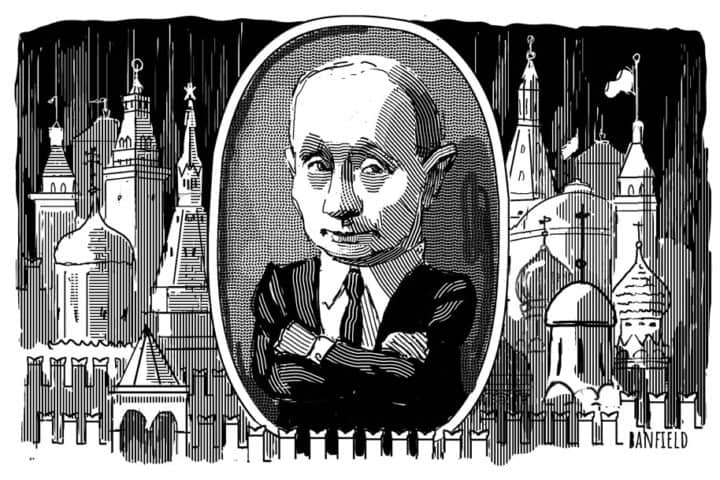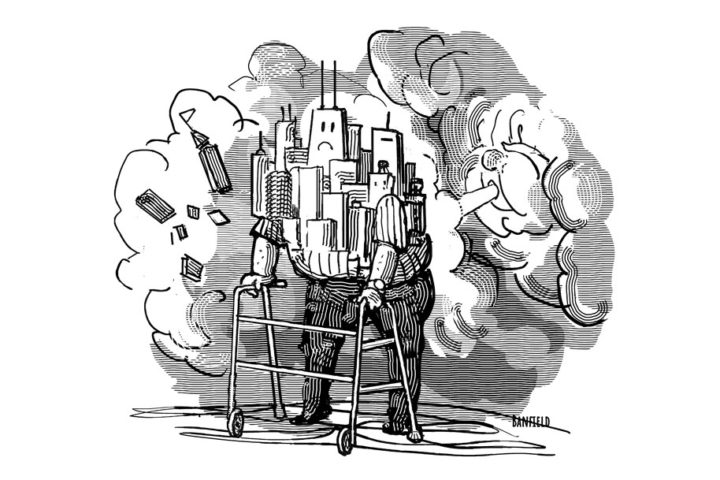Book Reviewed
Over the past decade, the biggest social development has been the cratering livability of the American cities that had been our most praised and prosperous. San Francisco, New York, Los Angeles, Seattle, and Portland were once the “Superstar Cities” hailed by urbanist guru Richard Florida. Having successfully attracted the “three Ts”—talent, tolerance, and technology—they were, he explained in The Rise of the Creative Class (2002), poised to play an increasingly dominant role in America’s economic and cultural life.
The brightest young people would continue to flock to these centers of harmonious flux, he predicted. New patterns of living built around bike lanes, food trucks, greenways, and dense multi-unit housing in neighborhoods “upzoned” for mixed use would appeal to college-educated knowledge workers. In turn, their high incomes—taxed heavily but just short of the point that impinged on the creative-class lifestyle—would support a robust social service infrastructure for the underprivileged.
This rosy dream of America’s New Urban future appeared to be materializing 20 years ago, though there were already signs of stress. Opioid overdose deaths, which had been climbing steadily since 1999, surged upward around 2014, as prescription pill abuse subsided while consumption of heroin increased. Even worse was the growing trade in fentanyl and other powerful synthetics, whose potency is so ferocious that it is impossible to titrate dosages without the use of laboratory-grade equipment. Street homelessness began to soar in cities cursed with a temperate climate.
* * *
In the last five years, the urbanist fantasy crashed hard. Crime soared nationwide, but disproportionately so in cities. Some that have been dystopian for generations, like Baltimore, Detroit, and St. Louis, still top the list of the most murderous cities in the country. But life is increasingly grim even in the places recently assumed to be winners. “Walkability,” once the gold standard of urban amenities, suddenly tarnished, as plazas, open spaces, and car-free streets became zones of social dysfunction and crime.
San Francisco, in particular, has always had a bohemian, tolerant attitude toward street people. Neighborhoods like the Tenderloin have been well known for their vice trade, single-room occupancy hotels, and hardscrabble down-and-outers for over a century. But in the last ten years the dysfunction has spread, with tent-based encampments—some official, others not, all tolerated—appearing throughout the city.
Open drug use is common, and social media is awash in pictures of sidewalks and playgrounds covered with a sludge of human excrement, dotted with discarded syringes. Untreated mental illness is endemic, and zombie movie comparisons have become clichéd. At the same time, San Francisco (and the Bay Area at large) is home to more than 100 billionaires and has the highest density of Michelin-starred restaurants (per capita) in the country.
* * *
In San Fransicko, Michael Shellenberger demonstrates how the human misery in America’s most beautiful city vindicates his subtitle, Why Progressives Ruin Cities. Shellenberger, a former independent candidate for governor of California, occupies a kind of no-man’s-land on the ideological spectrum. Nominally a liberal environmentalist and author of Apocalypse Never: Why Environmental Alarmism Hurts Us All (2020), he irks fellow progressives with his support for nuclear energy and his insistence that eco-catastrophism is overblown.
At heart, San Fransicko is an exposé of how a progressive urban laboratory blessed with almost endless resources has doomed itself to perpetuate and expand the dysfunctional conditions it set out to resolve. With unparalleled access to the functionaries at the heart of the region’s social service complex, Shellenberger offers those do-gooders enough rope to hang not only themselves but every other public health expert and sociologist in the Bay Area. He shows how advocates have approached the interrelated problems of homelessness, drug addiction, and mental illness precisely backward.
America is in the middle of a housing crisis, the problem concentrated in big expensive cities where so many want to live. Soaring rents have priced many young people out of the property market, a problem exacerbated by environmental regulations and high building costs in large, blue cities where organized labor retains a grip on local practices. At the same time and in largely the same places, homelessness is an acute problem.
It’s easy to say that these two problems are really one: homelessness is driven by the high cost of housing, and the poor are squeezed out. And there is a certain superficial truth to this idea. Mississippi and West Virginia, for example, have the lowest median housing costs in the nation, and very little homelessness: the entire state of Mississippi counts only 1,100 homeless people, whereas the city of Fresno, with one-sixth the population, is burdened with four times as many homeless. But conversely, it’s easy to say that homelessness is driven by poverty, which is certainly true, too…except that Mississippi and West Virginia, again, with relatively few homeless people, are two of the poorest states in the nation.
Shellenberger talks to advocates of the “Housing First” agenda, which is based on the premise that, as its name implies, housing is the basis of functional living. They argue that homeless people, now properly referred to as “the unhoused,” should be granted housing as a fundamental human right. All other problems they may have, such as drug addiction or mental illness, are secondary to their lack of housing, which therefore must be made available without preconditions.
* * *
Housing First, which Shellenberger describes as virtually a religious belief, dominates homelessness policy in San Francisco. Backed by billionaires like Salesforce founder and Time magazine owner Marc Benioff, Housing First promoted Proposition C, which voters enacted in 2018. It raised taxes on area landlords and doubled spending on the homeless to almost $1 billion every two years. Yet Housing First advocates reject any solution short of permanent housing, so they oppose homeless shelters or other temporary and emergency measures. “Everyone deserves a granite countertop,” is how Andy Bales, a Skid Row shelter provider, describes the prevailing mindset.
Yet giving generous benefits to the poor multiplies rather than solves a municipality’s problems. Shellenberger explains that only one fifth of the homeless population in San Francisco was born there. The rest came for the benefits—“cheap and abundant drugs,” “lax law enforcement,” and direct cash handouts to the homeless that most other cities have limited or discontinued altogether.
Closely related to the principle of housing as an unalloyed right is the idea of harm reduction for drug addicts. Proponents insist that discouraging people from using drugs leads to stigmatization, which leads to unsafe practices, which cause people to overdose, often fatally. Shellenberger, once an activist for drug decriminalization and harm reduction, describes how San Francisco gives out more needles than New York City, which is ten times bigger, yet is tied with West Virginia for the highest rate of overdose deaths in the country.
Keith Humphreys, a Stanford researcher and advisor to the Obama White House on drug policy, promoted the use of opioid antagonists such as Narcan in order to reverse overdose. San Fransicko shows that he is considered a reactionary in the Bay Area for opposing the full legalization of heroin. Humphreys makes the trenchant point that haphazard dosing with irregularly produced product is not really the main driver of death by opioid overdose. “‘If it is really true that the problem is contaminants,’ said Humphreys, ‘that opioids are not being made and distributed under tight regulation by legal manufacturers, then no one would ever have died from OxyContin.’”
Radical proponents of harm reduction in San Francisco see drug addiction as a rational response to social ills such as “trauma and generations in poverty.” But Shellenberger finds that the fiercest critics of harm reduction policies are former addicts who themselves suffered poverty and trauma, but recovered from addiction through “intense commitment” to moral renewal.
* * *
Along with runaway drug abuse and the reluctance to impose stigma or penalties on users, San Francisco is bedeviled by thousands of people with serious, untreated mental illnesses. Some of them, schizophrenic or manic-depressive, “self-medicate” with drugs or alcohol that intensify their symptoms when they fail to numb them. Not so much deinstitutionalized as “transinstitutionalized,” to use Shellenberger’s term, these lost souls cycle between emergency rooms, locked psychiatric hospital wards, jails, and the streets in a tragic downward spiral.
The ’60s spirit of radical libertinism, which made “the Haight” the center of the psychedelic universe, persists in affirming the right of manifestly sick and suffering people to live on the streets daubed in their own filth. The author quotes Willie Brown, mayor of San Francisco from 1996 to 2004, describing an “evil synthesis” of forces that allied to prevent the truly suffering from getting help. Having deconstructed psychiatry as an agent of the carceral state, activists promote the idea that untreated serious mental illness is an alternative way of seeing the world, as valid as any other. Who are we to say that the naked fellow eating garbage and screaming at ghosts isn’t living his best life?
We are living through a period when fantastically rich but morally impoverished American cities are committing slow-motion suicide. San Fransicko is Michael Shellenberger’s shocking first draft of an autopsy.





